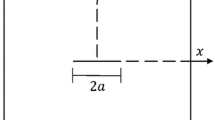Abstract
A new iterative method for elastic-plastic stress analysis based on a new approximation of the constitutive equations is proposed and compared with standard methods on the accuracy and the computational time in a test problem. The proposed method appears to be better than the conventional methods on the accuracy and comparable with others on the computational time. Also the present method is applied to a crack problem and the results are compared with experimental ones. The agreement of both results are satisfactory.
Similar content being viewed by others
Abbreviations
- u = (u 1, u 2):
-
displacements Δu (H) = u (n+1) - u (n) Δu (n) k = u (n + 1)(k - u (n) (n, k = 0, 1, 2, ...)
- σ = σ11, σ22, σ12):
-
stresses
- ɛ = (ɛ11, ɛ22, ɛ12):
-
strains
- α = (α11, α22, α12):
-
center of yield surface
- D :
-
elastic coeffficient matrix, C = D −1
- ϕ:
-
von Mises yield function. The initial yielding is given by f(σ) = σ Y
- ∂f:
-
{∂f/∂σ}
- ∂ϕ* :
-
transposed ∂f
- H′:
-
hardening parameter (assumed to be a positive constant for kinematic hardening problems)
- \(\dot \sigma \) :
-
time derivative of σ
- [K]:
-
total elastic stiffness matrix
- T :
-
traction vector
- ɛ = [B]ũ:
-
relation between nodal displacements and strains
References
Hutchinson, J. W. (1968): Singular behavior at the end of a tensile crack in a hardening material. J. Mech. Phys. Solids 16, 13–31
Miyoshi, T. (1985): Foundations of the numerical analysis of plasticity. North-Holland Mathematics studies 107. Kinokuniya/North-Holland
Miyoshi, T. (1986): A new iterative method for solving quasi-static problems of plasticity. Japan J. Appl. Math. 3/2, 331–342
Miyoshi, T.; Kaminishi, K.; Kawano, S.; Shimizu, S. (1986): An iterative method for elastic-plastic stress analysis. Comp. Mech., ICCM (Tokyo, Japan) 1, IV89-IV94
Miyoshi, T.; Kaminishi, K.; Kawano, S. (1986): Finite element program EPITOK-II. Technol. Rpts. Yamaguchi University, Vol. 3, 5, 441–471
Shimizu, S.; Kawano, S.; Ishii, M.; Iiyama, N. (1983): An experimental study on strain distribution in the near-tip feild under the general yielding and crack growth. Bull. JSME 26/221, 1863–1870
Simo, J. C.; Taylor, R. L. (1986): A return mapping algorithm for plane stress elastoplasticity. Int. J. Numer. Meth. in Eng. 22, 649–670
Yamada, Y.; Yoshimura, N.; Sakurai, T. (1968): Plastic stress-strain matrix and its application for the solution of elasticplastic problems by the finite element method. Int. Mech. Sci., 10, 343–354
Zienkiewicz, O. C. (1977): The finite element method, 3rd ed. New York: McGraw-Hill.
Author information
Authors and Affiliations
Additional information
Communicated by G. Yagawa June 17, 1987
Rights and permissions
About this article
Cite this article
Miyoshi, T., Kaminishi, K. & Kawano, S. Application of a new iterative method for elastic-plastic stress analysis. Computational Mechanics 3, 371–379 (1988). https://doi.org/10.1007/BF00301138
Issue Date:
DOI: https://doi.org/10.1007/BF00301138




